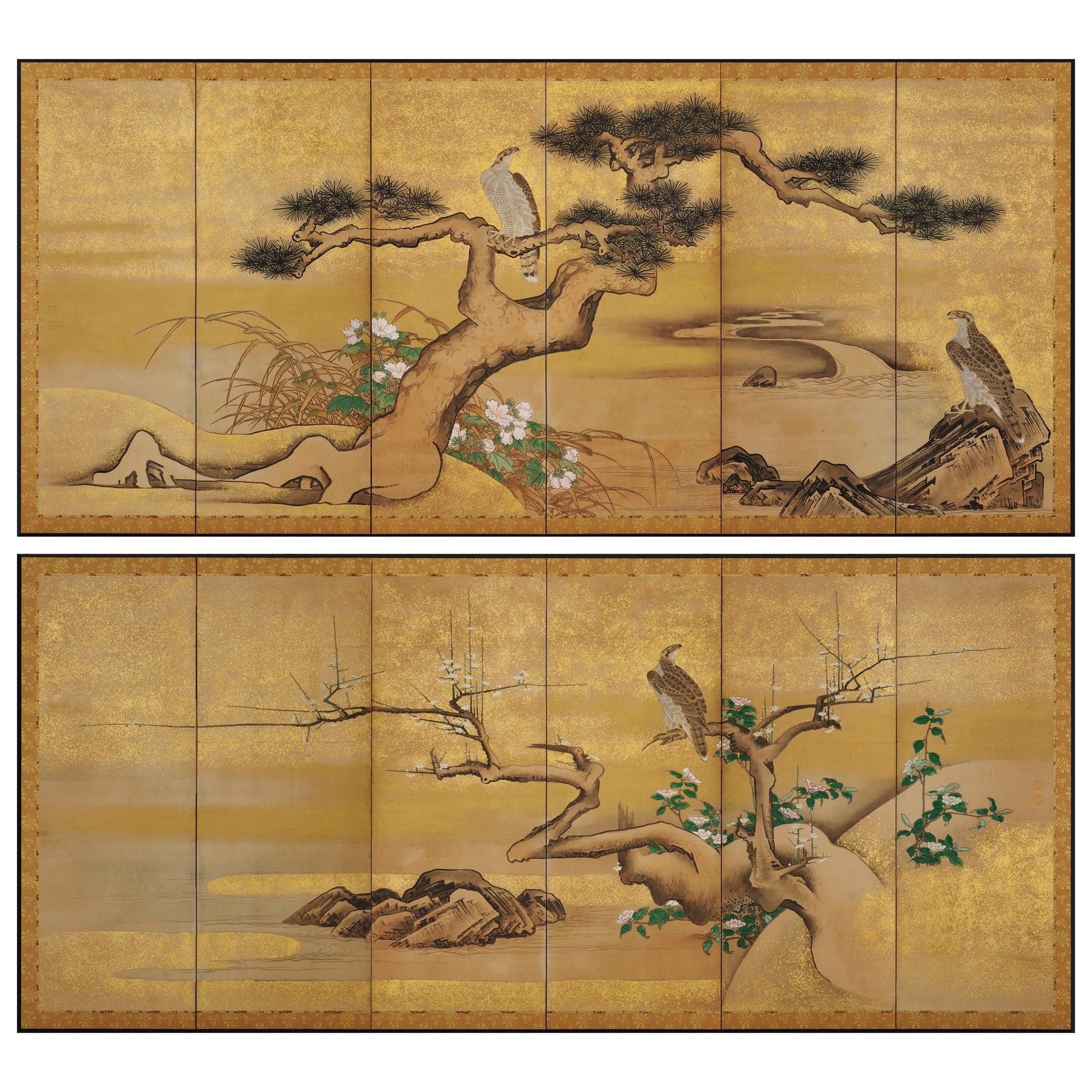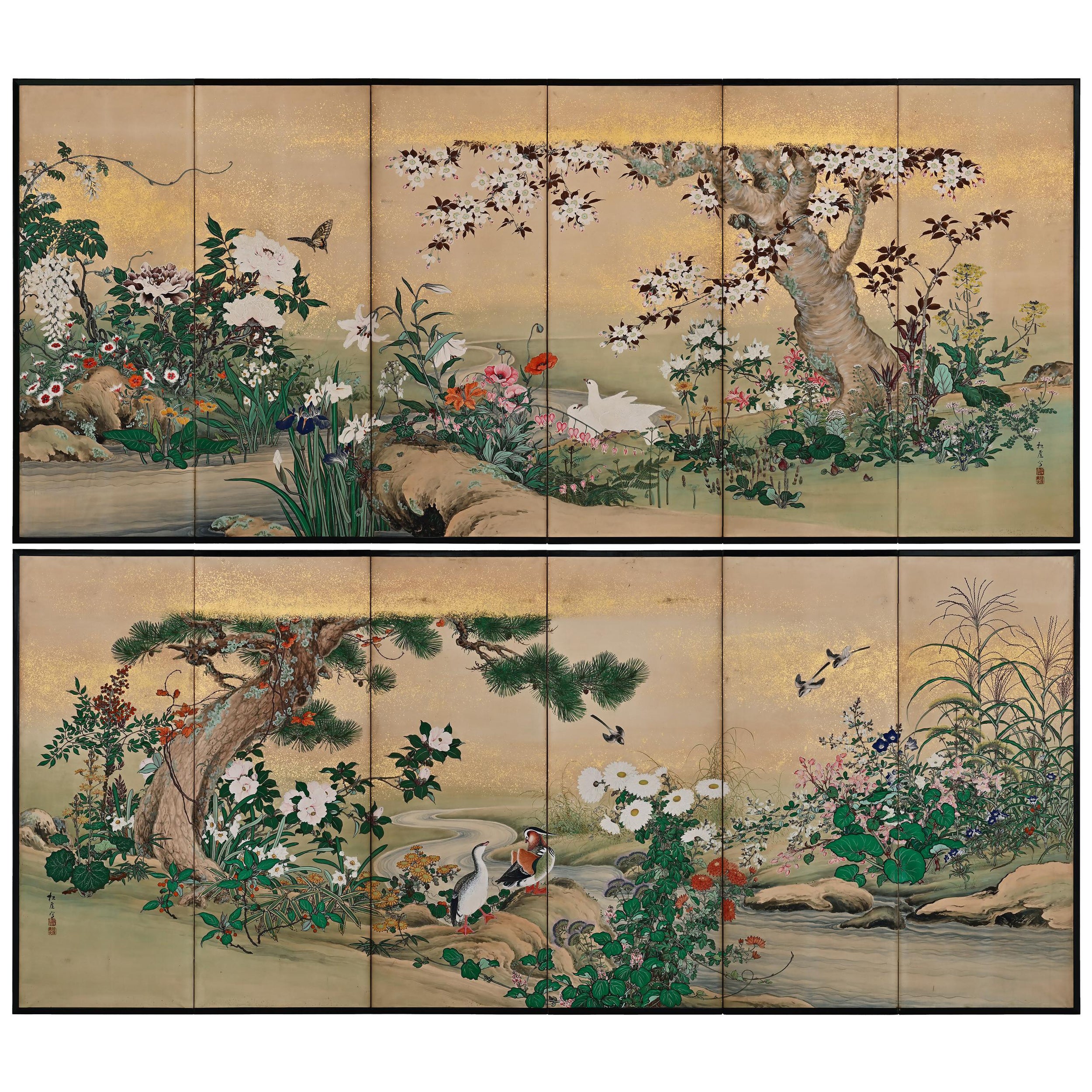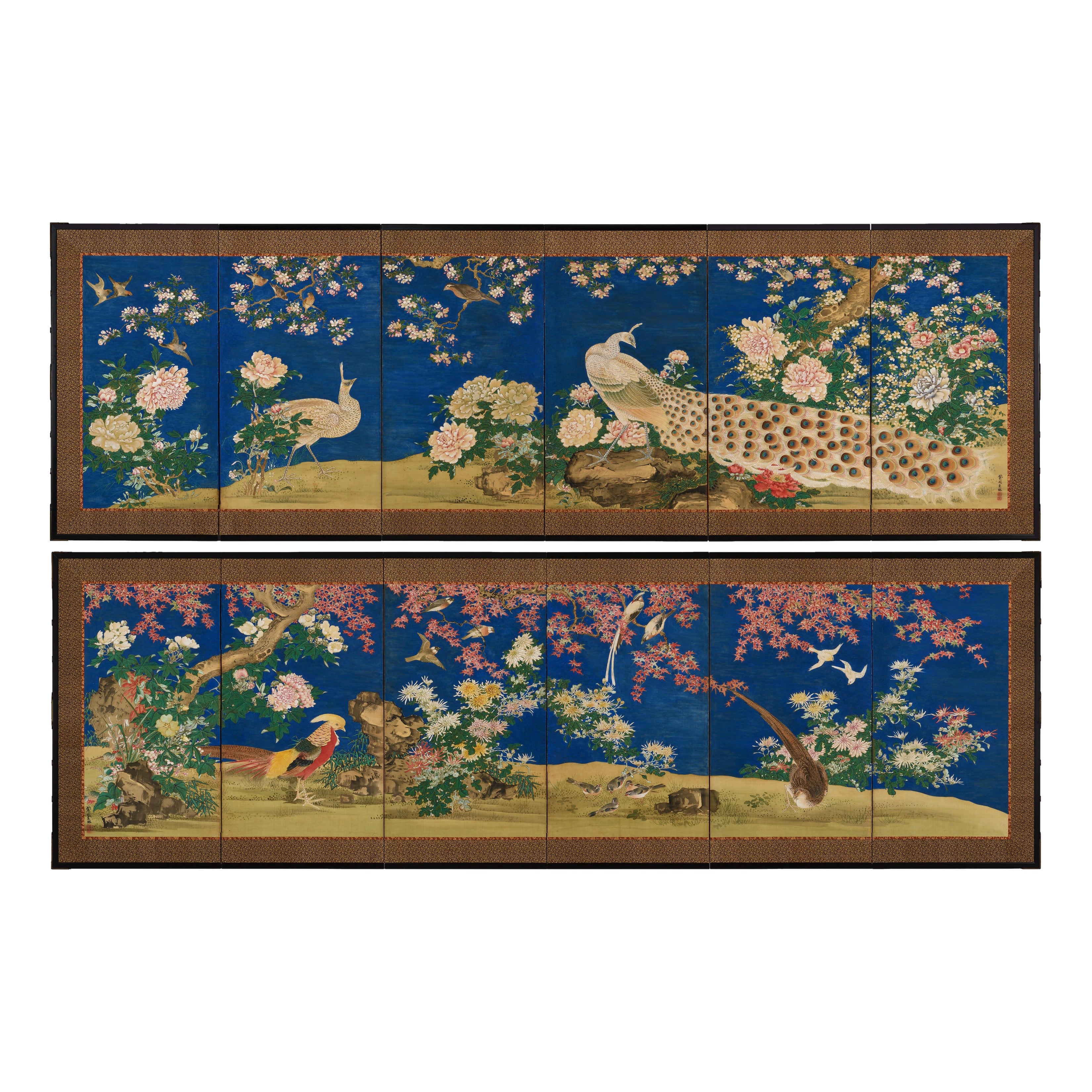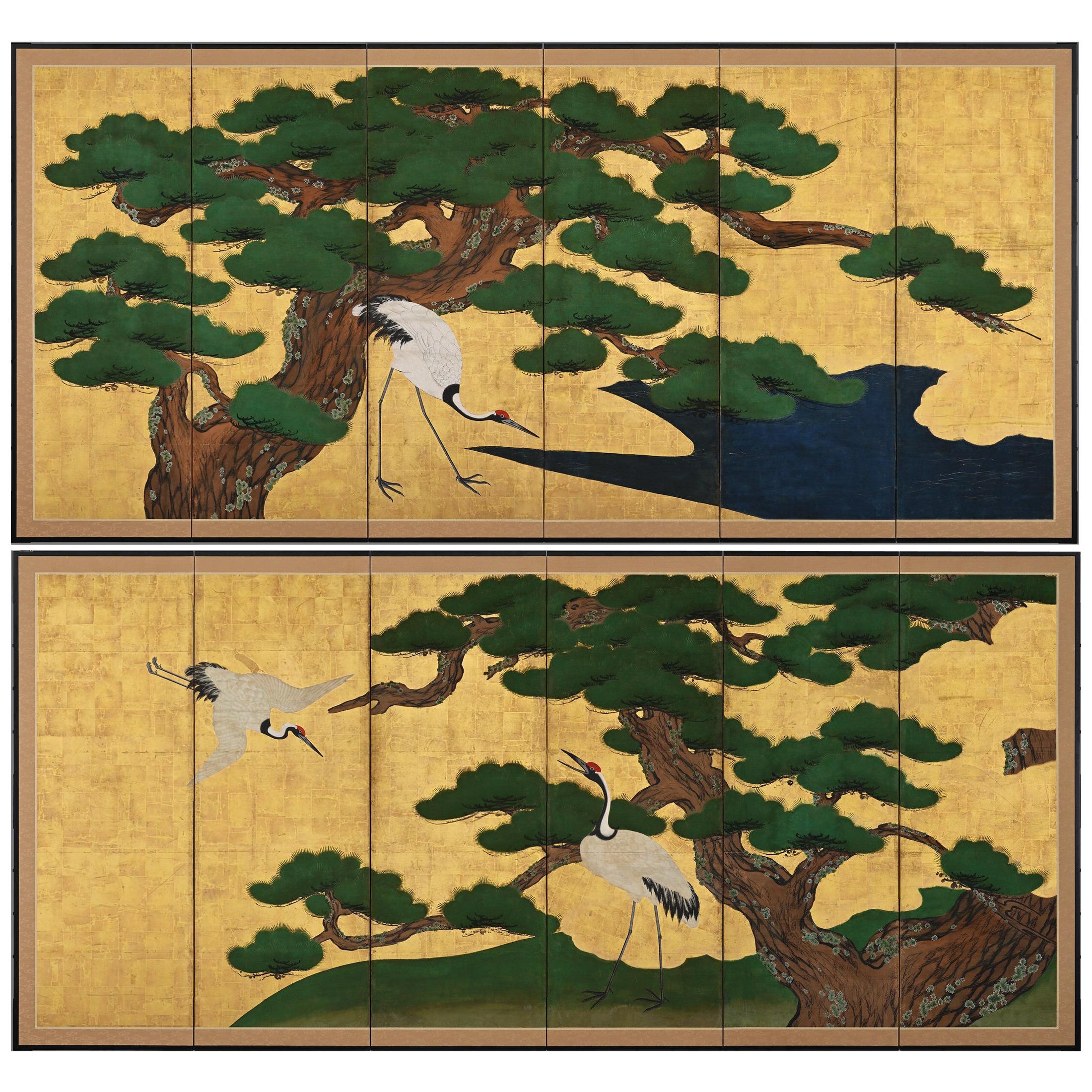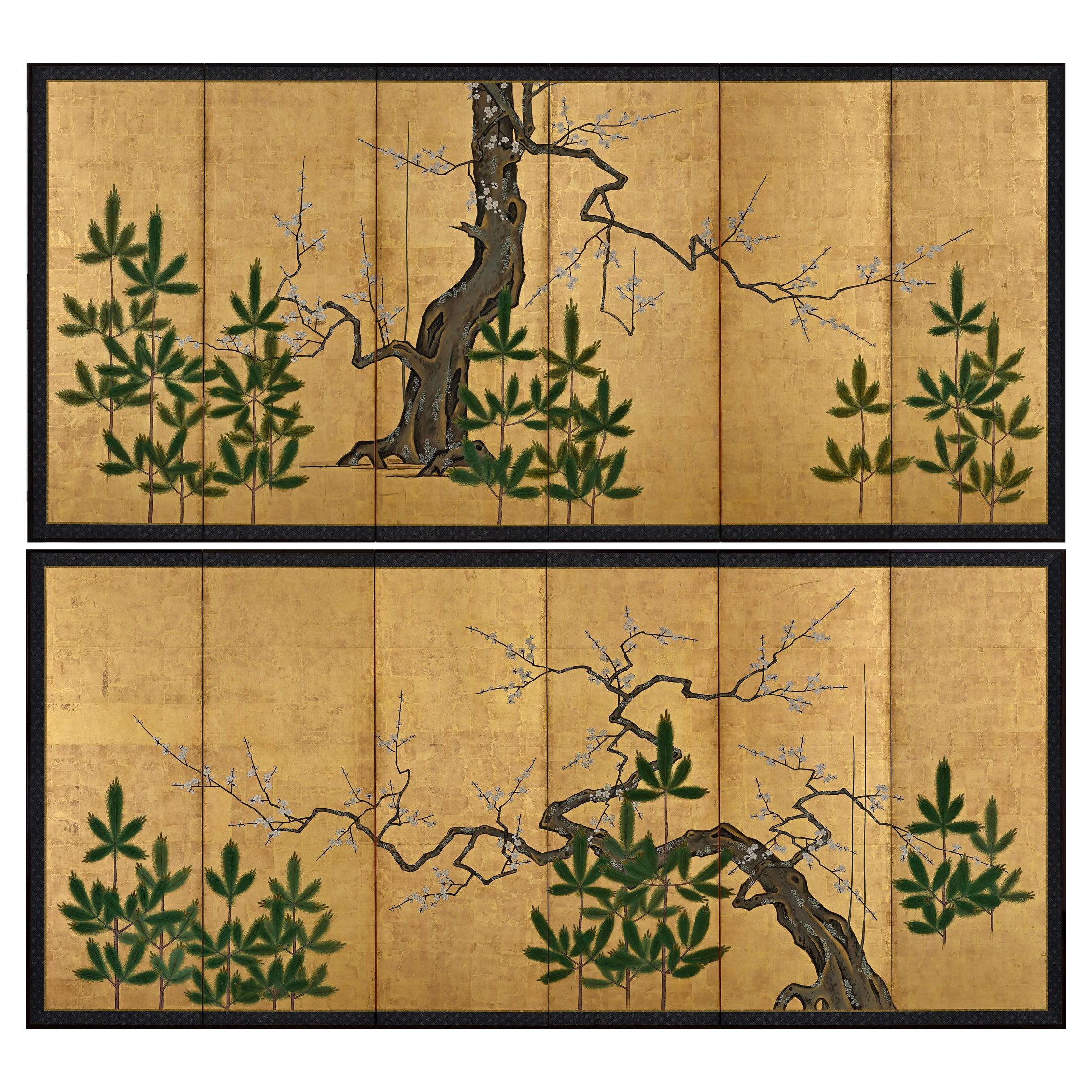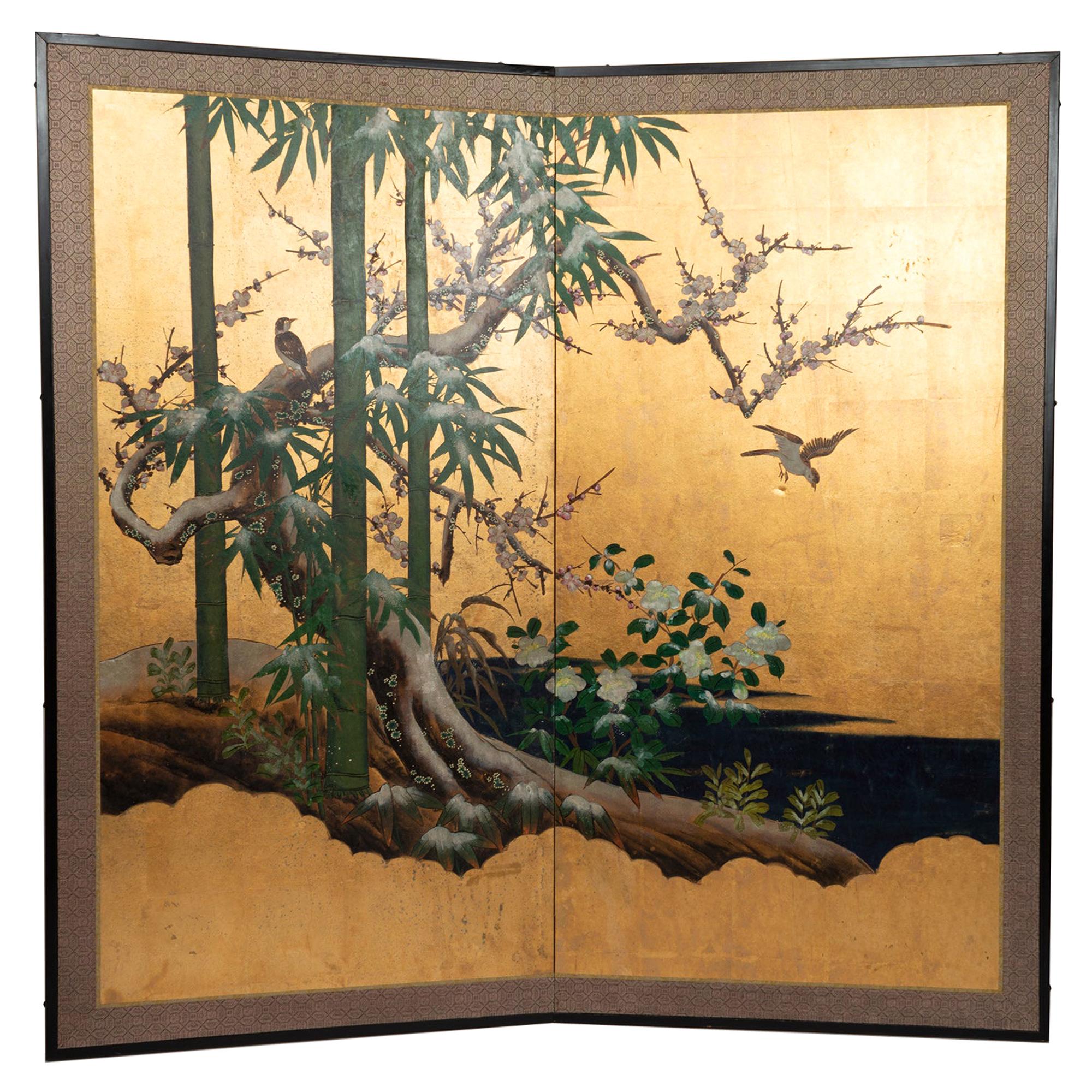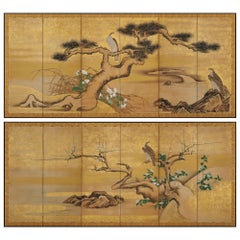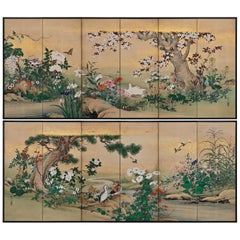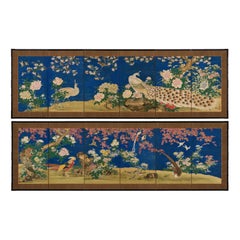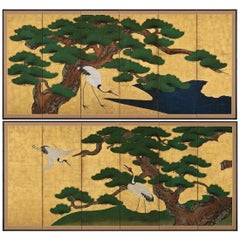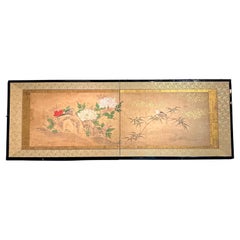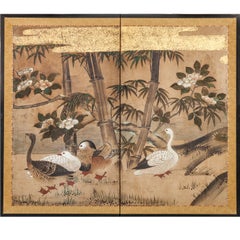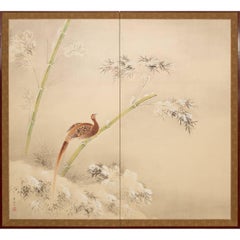Items Similar to Japanese Screen Pair, circa 1730, Peacocks and Phoenix, Kano School
Want more images or videos?
Request additional images or videos from the seller
1 of 10
Japanese Screen Pair, circa 1730, Peacocks and Phoenix, Kano School
$42,500per set
£32,271.26per set
€36,904.59per set
CA$59,378.66per set
A$66,042.03per set
CHF 34,485.10per set
MX$803,661.32per set
NOK 440,427.33per set
SEK 413,043.14per set
DKK 275,433.11per set
Shipping
Retrieving quote...The 1stDibs Promise:
Authenticity Guarantee,
Money-Back Guarantee,
24-Hour Cancellation
About the Item
Phoenix and Peacocks.
A pair of six-panel Japanese folding screens by Tsunetake Yotei (n.d.)
First half of the 18th century.
The signature reads 67 year old Tsunetake.
The seals read:
-Tsunetake no in,
-Yotei,
-Seishin
Dimensions:
Each screen – H. 69” x W. 149” (176 cm x 378 cm)
A pair of Kano Grand Picture (Waga) screens depicting phoenix and peacocks rich with symbolic meaning. Dating to the first half of the 18th century, from the Kobikicho Kano school in Edo, this pair of folding screens spring from the height of the Japanese Tokugawa reign. The Kano school of art was within the Tokugawa dispensation and provided for its internal needs rather than a public constituency. A Kano decorated castle, or temple, was a way to acquire military standing and to ensure confidence in the steadfastness of their virtue. Temple residences, especially senior abbacies, were decorated similarly to castles, unsurprisingly as they were sponsored by the same warriors. Beyond image halls and places of ritual exercise, temples had abbacies, monastic living quarters and guest houses, all of which would be ornamented, as rich as any mansion, and in not a dissimilar way.
Kano Grand-Picture Waga invokes the broad notion of auspiciousness, especially its political dimension. The mythical phoenix was a symbol of peace and would only appear in a kingdom blessed with prosperity during the reign of a virtuous emperor. The paulownia tree was regarded as sacred and home to the phoenix, and the phoenix and paulownia together carried strong auspicious connotations. Peacocks communicate high status, wealth and power. This pair of screens would have left no doubt as to the status of their owner or patron.
Waga was understood as bold and colorful, with copious use of gold. The artists strived for luxurious tints and beautiful appearances. This pair of screens epitomize the concept and the startlingly fresh pigments and sublimely hued gold leaf effortlessly sweep the viewer to a previous epoch.
Tsunetake Yotei was an artist of the Kano school. He is listed in Araki Nori. Dai-Nihon Shoga Meika Taikan (Dictionary of Great Japan Calligraphy and Painting Masters). Tokyo: Dai-ichi Shobo. 1975. p.2435. His dates are unknown. Almost certainly he was a student of Kano Tsunenobu Yoboku (1636-1713) of the Kobikicho Kano. All of Tsunenobu’s well-known students used the first and third characters of his name, as is the case with Tsunetake Yotei.
- Dimensions:Height: 69 in (175.26 cm)Width: 149 in (378.46 cm)Depth: 0.75 in (1.91 cm)
- Sold As:Set of 2
- Style:Edo (Of the Period)
- Materials and Techniques:
- Place of Origin:
- Period:
- Date of Manufacture:circa 1730
- Condition:Wear consistent with age and use.
- Seller Location:Kyoto, JP
- Reference Number:1stDibs: LU2472319431222
About the Seller
5.0
Recognized Seller
These prestigious sellers are industry leaders and represent the highest echelon for item quality and design.
Established in 2001
1stDibs seller since 2016
70 sales on 1stDibs
Typical response time: 6 hours
- ShippingRetrieving quote...Shipping from: Kyoto, Japan
- Return Policy
Authenticity Guarantee
In the unlikely event there’s an issue with an item’s authenticity, contact us within 1 year for a full refund. DetailsMoney-Back Guarantee
If your item is not as described, is damaged in transit, or does not arrive, contact us within 7 days for a full refund. Details24-Hour Cancellation
You have a 24-hour grace period in which to reconsider your purchase, with no questions asked.Vetted Professional Sellers
Our world-class sellers must adhere to strict standards for service and quality, maintaining the integrity of our listings.Price-Match Guarantee
If you find that a seller listed the same item for a lower price elsewhere, we’ll match it.Trusted Global Delivery
Our best-in-class carrier network provides specialized shipping options worldwide, including custom delivery.More From This Seller
View All17th Century Japanese Screen Pair by Soga Nichokuan, Hawks on Pine & Plum Trees
Located in Kyoto, JP
Hawks on plum and pine
Soga Nichokuan (active circa 1625-1660)
Pair of six-fold screens.
Ink, mineral pigments, gofun, gold and speckled gold l...
Category
Antique 1640s Japanese Edo Paintings and Screens
Materials
Wood, Paper
19th Century Japanese Screen Pair. Flowers & Birds of the Four Seasons
Located in Kyoto, JP
Flowers & Birds of the Four Seasons
Pair of six-fold Japanese Screens. Ink, color, gofun and gold on paper.
Second half of the 19th Centur...
Category
Antique Late 19th Century Japanese Meiji Paintings and Screens
Materials
Wood, Paper
Mid 19th Century Japanese Screen Pair. Flowers & Birds of the Four Seasons.
Located in Kyoto, JP
Shioka Sorin (1781-1850)
Flowers & Birds of the Four Seasons
Pair of six-panel Japanese Screens. Ink, gofun and pigments on silk.
Dimensions (each screen): H. 91.5cm x W. 285cm (3...
Category
Antique Mid-19th Century Japanese Edo Paintings and Screens
Materials
Silk
Circa 1700 Japanese Screen Pair, Cranes & Pines, Kyoto Kano School
Located in Kyoto, JP
Pines and Cranes
Anonymous. Kyoto Kano School.
Late 17th/early 18th centuries, circa 1700.
Pair of six-panel Japanese folding screens.
Ink, gofun, pigment and gold leaf on paper.
This bold composition presents two pine trees extending to the left and right across a gold leaf background. One tree is silhouetted against a green ground, golden clouds obscuring its true size, the other stretches across a stylized waterway. The pines are paired with Manchurian cranes with red crests and snow white plumage. Both have been highly auspicious motifs in East Asia since Chinese antiquity. Here the artist utilized fluid and instinctive ink brushstrokes to define the trunk, branches and tail feathers, in strong contrast to the precision and sharp angularity of the crane’s legs and beaks. The adoption of this vast metallic painting support required an unerring sense of design and composition, so that the negative space surrounding motifs could imply context for the otherwise floating pictorial elements. The brushwork detailing the trunks of the pines, the exaggerated dimensions of the pine trees and the strength and dynamism of the composition are all reminiscent of Kano Eitoku...
Category
Antique Late 17th Century Japanese Edo Paintings and Screens
Materials
Gold Leaf
18th Century Japanese Screen Pair. Plum & Young Pines. Kano School.
Located in Kyoto, JP
Dimensions (Each screen): H. 176 cm x W. 378 cm (69’’ x 149’’)
This pair of Japanese folding screens depict blossoming plum trees amongst young pines. They are designed to capture t...
Category
Antique Late 18th Century Japanese Edo Paintings and Screens
Materials
Gold Leaf
Early 19th Century Japanese Screen. Cherry Blossom & Pheasants by Mori Tetsuzan
Located in Kyoto, JP
Mori Tetsuzan (1775-1841)
Pheasants and Cherry Blossoms
Two-fold Japanese screen. Ink, color, gofun, gold and silver on paper.
A two-fold Japanese bir...
Category
Antique Early 19th Century Japanese Edo Paintings and Screens
Materials
Gold Leaf
You May Also Like
Antique 19th Century Japanese Two-Panel Screen ‘Byobu’, Kano School, Edo Period
Located in London, GB
Japanese Kano School Edo period two-panel screen depicting flowering prunus and bamboo on a rock formation, with colorful birds next to a body of water. ...
Category
Antique Mid-19th Century Japanese Edo Paintings and Screens
Materials
Gold Leaf
Japanese "Magpie and Peony" Two Panel Screen, Edo Period, 18th/19th century
Located in Austin, TX
A sublime Japanese two panel "Magpie and Peony" screen, ink and color on paper, Edo Period, late 18th or early 19th century, circa 1800, Japan.
The two panel screen features a wond...
Category
Antique Early 19th Century Japanese Edo Paintings and Screens
Materials
Copper
Japanese Two Panel Screen: Mandarin Ducks and Geese Among Bamboo and Flowers
Located in Hudson, NY
Japanese Two Panel Screen: Mandarin Ducks and Geese Among Bamboo and Flowers, Edo period painting (c. 1850) of mandarin ducks and geese on a grassy sh...
Category
Antique Mid-19th Century Japanese Edo Paintings and Screens
Materials
Gold
Japanese Two Panel Screen: Pheasant and Snow Covered Bamboo
Located in Hudson, NY
Early Taisho period painting (1912 - 1926) in mineral pigments on mulberry paper with a silk brocade border. Artist signature reads: Kisho saku. Kisho Shibahara (1885-1954).
Category
Early 20th Century Japanese Taisho Paintings and Screens
Materials
Paper
Japanese Two Panel Screen Manchurian Crane and Turtles
Located in Hudson, NY
In Japan, cranes symbolize fidelity as they mate for life and turtles symbolize longevity. Additionally, this screen also has the Japanese motif of sho-chiku-bai, or the three friends of winter (pine, plum, and bamboo). So called the three friends of winter because all three flourish during the cold months. This screen was originally fusuma doors...
Category
Antique Mid-19th Century Japanese Edo Paintings and Screens
Materials
Paper
Japanese Rare Antique Pair Hand Painted Birds And Blue Waters Wedding screens
Located in South Burlington, VT
A lovely antique pair (2) Japanese hand-painted six-panel folding screens byobu- each conceived in an attractive birds, trees, and blue waters motif. Likely given as a wedding gift...
Category
Antique 19th Century Japanese Meiji Paintings and Screens
Materials
Wood, Paper
$760 Sale Price / set
20% Off
More Ways To Browse
Asian Gold Leaf Art
Japanese Phoenix
Pair Of Japanese Paintings
Japanese Folding Screens
18th Century Hand Screen
Japanese Screen Tree
Pair Of Japanese Screens
Edo Screen Gold
Antique Asian Folding Screen
Kano School
Japanese Peacock
Antique Picture Viewer
Antique Japanese Calligraphy
18th Century Japanese Screens
Folding Screen Gold Leaf
Japanese Kano Screen
Japanese Screen Kano School
Kano School Screen
